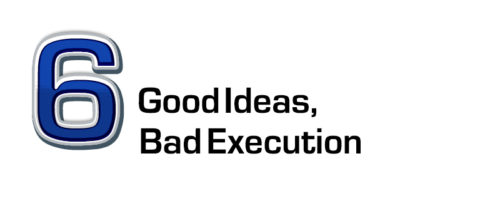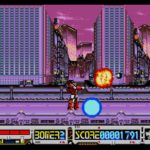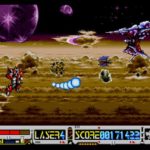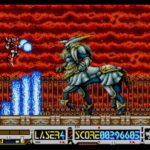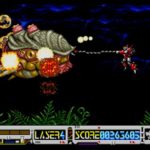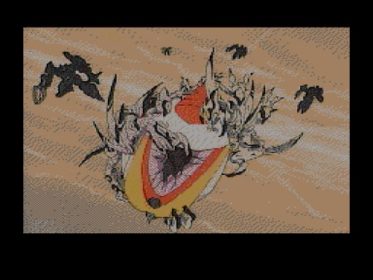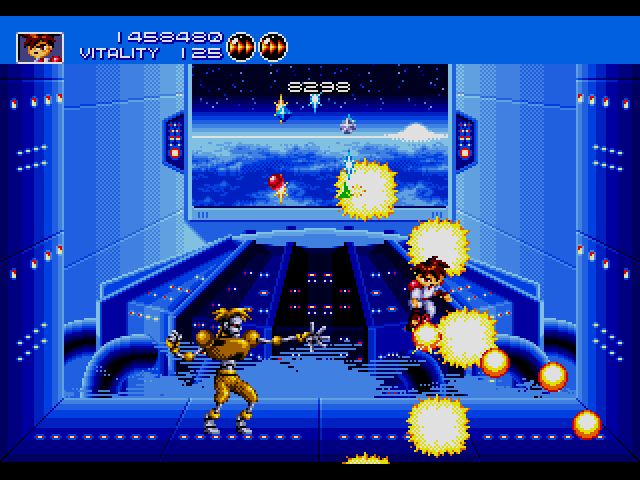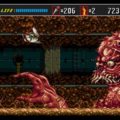In America the Sega CD is often looked back on as a wasteland full of terrible FMV games and licensed junk. That is true to an extent but when you dig deeper it has an alright library of diverse games. In Japan despite its middling sales the Mega CD was afforded a wider range of quality titles that we unfortunately missed out on. Devastator is not one of those games. Look past its extensive full motion video cutscenes and you are left with an average action game that wisely stayed overseas.
Your primary weapon is an anchor that covers half of the screen. This is supplemented by three additional weapons that bolt onto it. These are the spread shot, bombs, and lasers. Unlike most games the spread shot here is terrible. It is incredibly weak and not worth using despite covering the entire screen in bullets at full power. It’s a toss-up between the bombs and laser. Neither is more powerful than the other but I found the laser more useful as it travels across the screen. All weapons can be powered up four times and generally there are enough power-ups that it comes quickly. Too bad you won’t really need it.
As far as its gameplay Devastator is very average. The level design is very straightforward and offers very few surprises. Your mech is very mobile and not doddering but there is very little excitement to be had. You’ll encounter the same four or five enemies throughout the game that pose very little threat. While the side scrolling portions are middling the shooter stages pick up the slack. Despite your robot being a large hit target these levels are pretty tightly designed, with consistent enemy waves, bullet patterns to dodge and creative navigation of the environment. These are the strongest parts of the game and if the creators had poured given the other half of the game as much attention it would have been better for it.
For as average as the game is it does show the occasional spark of ingenuity most notably in its boss battles. Nearly every end level boss goes through multiple phases and transformations and possesses a nice variety of attacks. Depending on the weapon you’ve chosen these can be brief but engaging battles as you learn their pattern and execute or long grueling wars of attrition. Yet despite their complexity the game always remains fair. Normally I don’t like boss rushes yet here it is done properly, with only two before the final boss and the option to switch weapons and heal in between each. Now if only the rest of the game were this good.
Outside of the boss fights Devastator is not a challenging game. Without even trying I racked up a large number of extra lives but it wasn’t necessary. The levels are sparsely populated and the few enemies that do appear go down in one or two hits. You would have to go out of your way to die in fact. The shoot em up stages are livelier to the point where I almost wish the game were comprised of just that. It does pick up a bit toward the end but it needed that level of attention throughout the entire game.
For as much as I’ve harped on the gameplay this is a decent looking game. It lacks the technical prowess of Telenet’s other Sega productions but makes up for it with a diverse set of locales. The environments span neon cities, dark caves, and even an extravagant castle. There is a generous amount of sprite scaling going on but once again the shooter levels outshine the rest of the game and look fantastic. The music is also great, with a litany of composers contributing a number of music tracks spanning a range of styles.
As much as I like the presentation the primary reason this is a CD game and not a regular cartridge is just embarrassing to look at. The extensive number of anime cutscenes consist of chopped up clips from the first episode of the D-1 Devastator anime. Unfortunately they look terrible, grainy as all hell, and full of compression artifacts. If the cutscenes after every level were supposed to be a reward they failed miserably. That damn 64-color limit really hurt the system when it came to this stuff.
In Closing
We really did not miss out when Devastator was left in Japan. By 1993 the Genesis was on fire with classics like Shinobi III and Gunstar Heroes. Devastator simply can’t compete and would have been another lame cartridge game with a CD soundtrack. And not even a good one at that.
